Captify: Strategic Planning and Analysis Report - Business Strategy
VerifiedAdded on 2023/01/04
|18
|4448
|96
Report
AI Summary
This report provides a comprehensive analysis of Captify, a data-driven company specializing in search intelligence and advertising. The report begins with an introduction to Captify's business strategy, followed by an examination of the macro-environment using a PESTLE analysis, considering political, economic, social, technological, legal, and environmental factors. Stakeholder analysis is also conducted to assess the influence of different stakeholders on Captify's decisions. The internal environment is analyzed using McKinsey's 7S model and a SWOT analysis to identify strengths, weaknesses, opportunities, and threats. Furthermore, the report applies Porter's Five Forces model to assess the competitive landscape, evaluating the threat of new entrants, the threat of substitutes, and the bargaining power of buyers. Finally, the report concludes with strategic recommendations for Captify, based on the analysis of its internal and external environments and competitive forces.
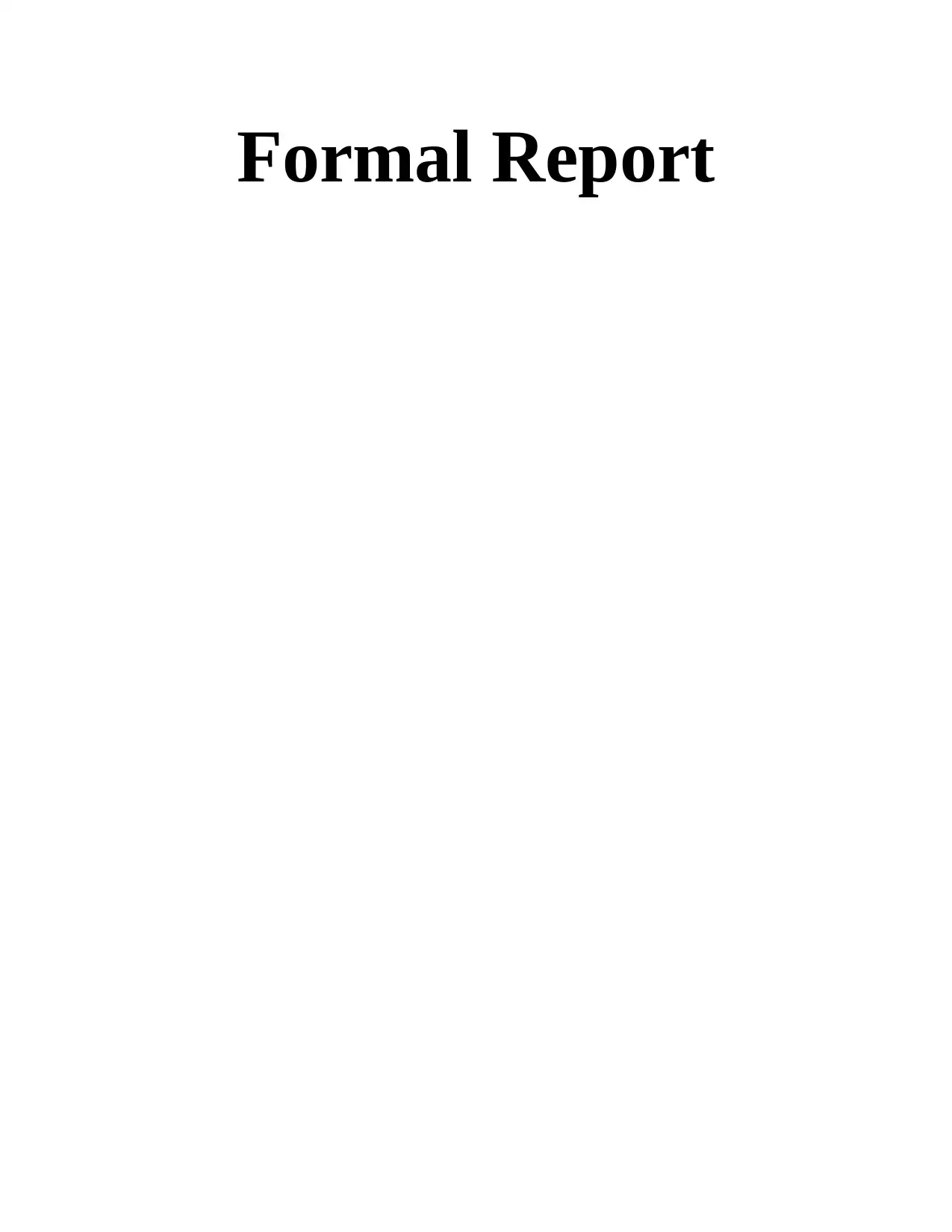
Formal Report
Paraphrase This Document
Need a fresh take? Get an instant paraphrase of this document with our AI Paraphraser

Table of Contents
INTRODUCTION...........................................................................................................................3
LO1..................................................................................................................................................3
P1 Impact and influence of Macro environment on organisation and its strategies....................3
LO2..................................................................................................................................................6
P2 Internal Environment and capabilities of organisation...........................................................6
LO3..................................................................................................................................................9
P3 Porter’s five forces Model......................................................................................................9
LO4................................................................................................................................................11
P4 Strategic Planning for Captify..............................................................................................11
CONCLUSION..............................................................................................................................15
REFERENCES..............................................................................................................................17
INTRODUCTION...........................................................................................................................3
LO1..................................................................................................................................................3
P1 Impact and influence of Macro environment on organisation and its strategies....................3
LO2..................................................................................................................................................6
P2 Internal Environment and capabilities of organisation...........................................................6
LO3..................................................................................................................................................9
P3 Porter’s five forces Model......................................................................................................9
LO4................................................................................................................................................11
P4 Strategic Planning for Captify..............................................................................................11
CONCLUSION..............................................................................................................................15
REFERENCES..............................................................................................................................17
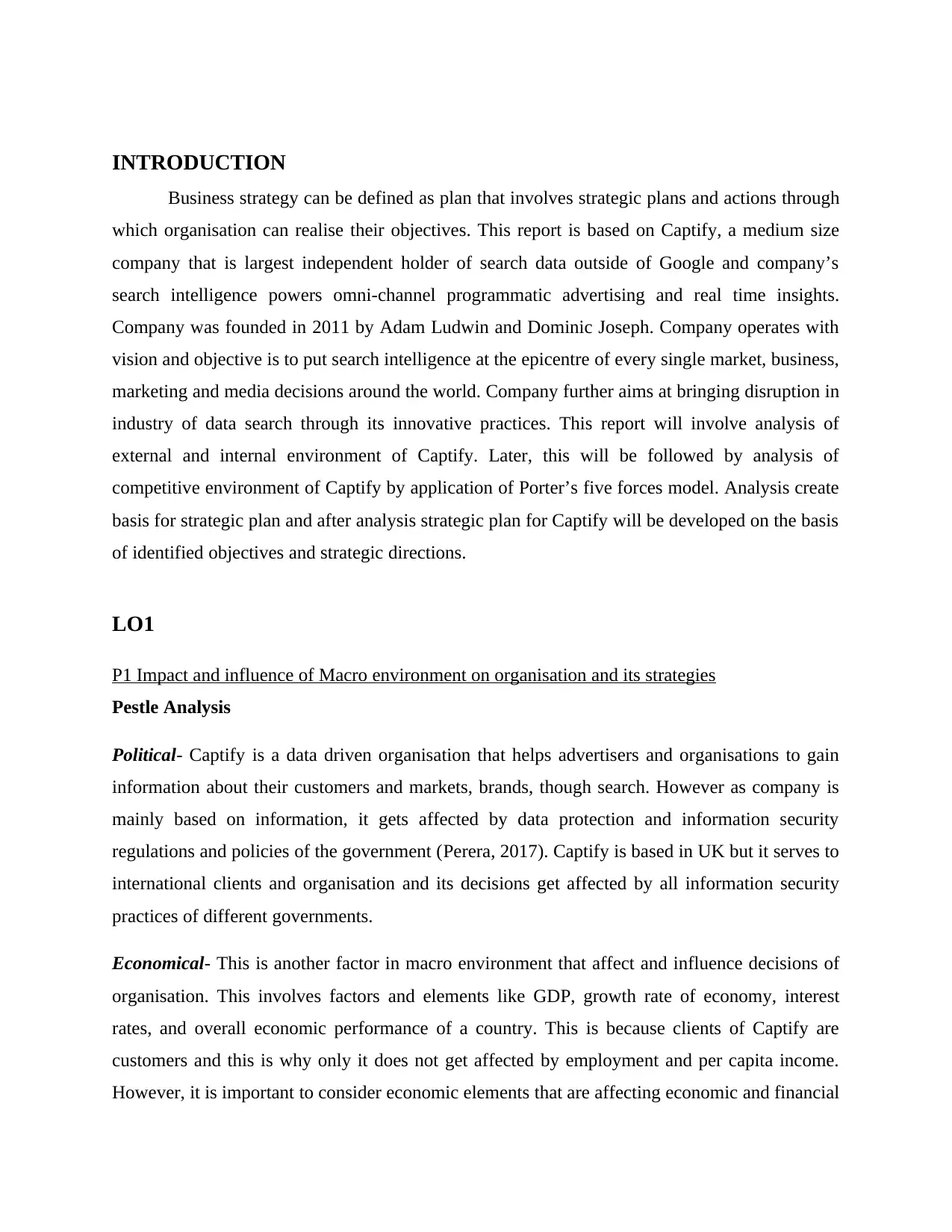
INTRODUCTION
Business strategy can be defined as plan that involves strategic plans and actions through
which organisation can realise their objectives. This report is based on Captify, a medium size
company that is largest independent holder of search data outside of Google and company’s
search intelligence powers omni-channel programmatic advertising and real time insights.
Company was founded in 2011 by Adam Ludwin and Dominic Joseph. Company operates with
vision and objective is to put search intelligence at the epicentre of every single market, business,
marketing and media decisions around the world. Company further aims at bringing disruption in
industry of data search through its innovative practices. This report will involve analysis of
external and internal environment of Captify. Later, this will be followed by analysis of
competitive environment of Captify by application of Porter’s five forces model. Analysis create
basis for strategic plan and after analysis strategic plan for Captify will be developed on the basis
of identified objectives and strategic directions.
LO1
P1 Impact and influence of Macro environment on organisation and its strategies
Pestle Analysis
Political- Captify is a data driven organisation that helps advertisers and organisations to gain
information about their customers and markets, brands, though search. However as company is
mainly based on information, it gets affected by data protection and information security
regulations and policies of the government (Perera, 2017). Captify is based in UK but it serves to
international clients and organisation and its decisions get affected by all information security
practices of different governments.
Economical- This is another factor in macro environment that affect and influence decisions of
organisation. This involves factors and elements like GDP, growth rate of economy, interest
rates, and overall economic performance of a country. This is because clients of Captify are
customers and this is why only it does not get affected by employment and per capita income.
However, it is important to consider economic elements that are affecting economic and financial
Business strategy can be defined as plan that involves strategic plans and actions through
which organisation can realise their objectives. This report is based on Captify, a medium size
company that is largest independent holder of search data outside of Google and company’s
search intelligence powers omni-channel programmatic advertising and real time insights.
Company was founded in 2011 by Adam Ludwin and Dominic Joseph. Company operates with
vision and objective is to put search intelligence at the epicentre of every single market, business,
marketing and media decisions around the world. Company further aims at bringing disruption in
industry of data search through its innovative practices. This report will involve analysis of
external and internal environment of Captify. Later, this will be followed by analysis of
competitive environment of Captify by application of Porter’s five forces model. Analysis create
basis for strategic plan and after analysis strategic plan for Captify will be developed on the basis
of identified objectives and strategic directions.
LO1
P1 Impact and influence of Macro environment on organisation and its strategies
Pestle Analysis
Political- Captify is a data driven organisation that helps advertisers and organisations to gain
information about their customers and markets, brands, though search. However as company is
mainly based on information, it gets affected by data protection and information security
regulations and policies of the government (Perera, 2017). Captify is based in UK but it serves to
international clients and organisation and its decisions get affected by all information security
practices of different governments.
Economical- This is another factor in macro environment that affect and influence decisions of
organisation. This involves factors and elements like GDP, growth rate of economy, interest
rates, and overall economic performance of a country. This is because clients of Captify are
customers and this is why only it does not get affected by employment and per capita income.
However, it is important to consider economic elements that are affecting economic and financial
⊘ This is a preview!⊘
Do you want full access?
Subscribe today to unlock all pages.

Trusted by 1+ million students worldwide
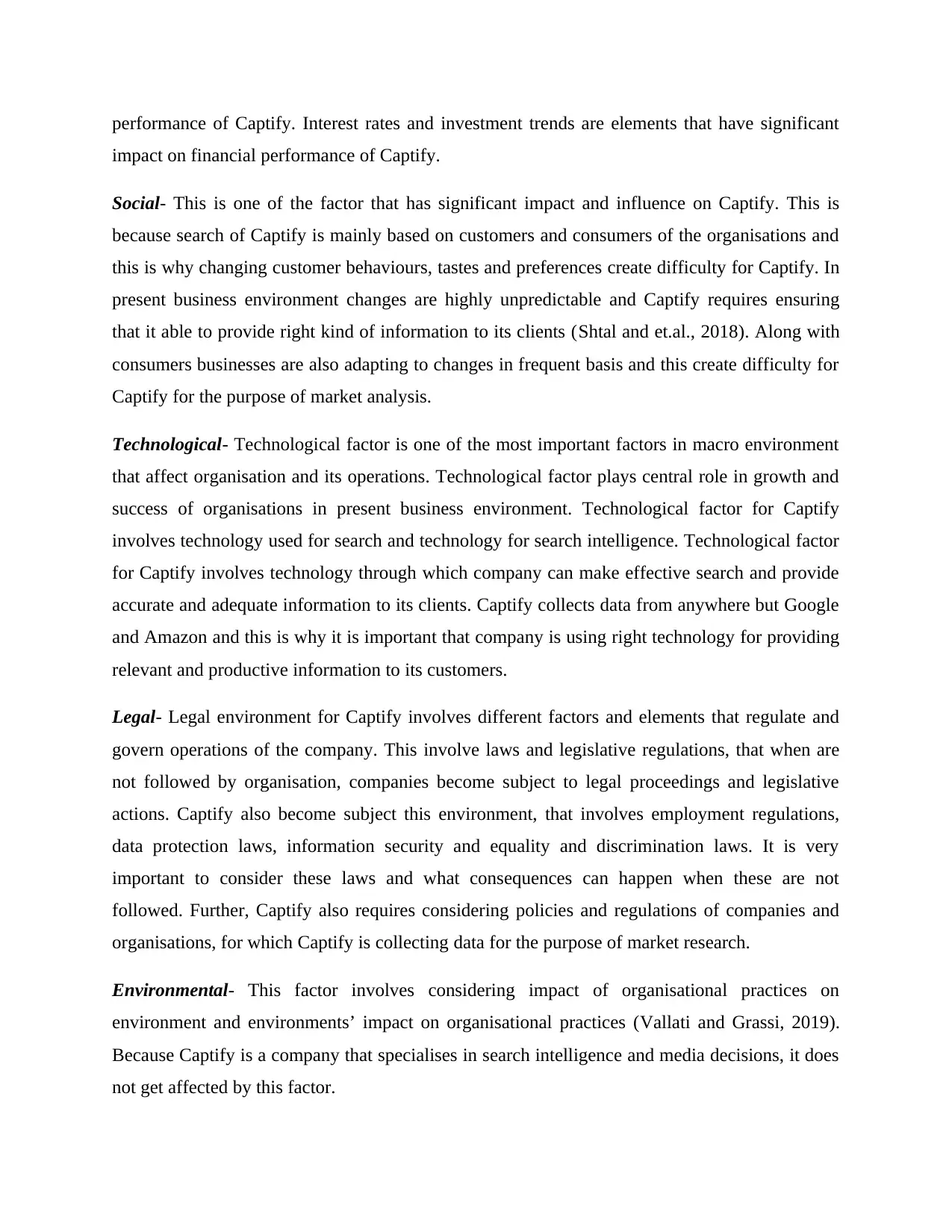
performance of Captify. Interest rates and investment trends are elements that have significant
impact on financial performance of Captify.
Social- This is one of the factor that has significant impact and influence on Captify. This is
because search of Captify is mainly based on customers and consumers of the organisations and
this is why changing customer behaviours, tastes and preferences create difficulty for Captify. In
present business environment changes are highly unpredictable and Captify requires ensuring
that it able to provide right kind of information to its clients (Shtal and et.al., 2018). Along with
consumers businesses are also adapting to changes in frequent basis and this create difficulty for
Captify for the purpose of market analysis.
Technological- Technological factor is one of the most important factors in macro environment
that affect organisation and its operations. Technological factor plays central role in growth and
success of organisations in present business environment. Technological factor for Captify
involves technology used for search and technology for search intelligence. Technological factor
for Captify involves technology through which company can make effective search and provide
accurate and adequate information to its clients. Captify collects data from anywhere but Google
and Amazon and this is why it is important that company is using right technology for providing
relevant and productive information to its customers.
Legal- Legal environment for Captify involves different factors and elements that regulate and
govern operations of the company. This involve laws and legislative regulations, that when are
not followed by organisation, companies become subject to legal proceedings and legislative
actions. Captify also become subject this environment, that involves employment regulations,
data protection laws, information security and equality and discrimination laws. It is very
important to consider these laws and what consequences can happen when these are not
followed. Further, Captify also requires considering policies and regulations of companies and
organisations, for which Captify is collecting data for the purpose of market research.
Environmental- This factor involves considering impact of organisational practices on
environment and environments’ impact on organisational practices (Vallati and Grassi, 2019).
Because Captify is a company that specialises in search intelligence and media decisions, it does
not get affected by this factor.
impact on financial performance of Captify.
Social- This is one of the factor that has significant impact and influence on Captify. This is
because search of Captify is mainly based on customers and consumers of the organisations and
this is why changing customer behaviours, tastes and preferences create difficulty for Captify. In
present business environment changes are highly unpredictable and Captify requires ensuring
that it able to provide right kind of information to its clients (Shtal and et.al., 2018). Along with
consumers businesses are also adapting to changes in frequent basis and this create difficulty for
Captify for the purpose of market analysis.
Technological- Technological factor is one of the most important factors in macro environment
that affect organisation and its operations. Technological factor plays central role in growth and
success of organisations in present business environment. Technological factor for Captify
involves technology used for search and technology for search intelligence. Technological factor
for Captify involves technology through which company can make effective search and provide
accurate and adequate information to its clients. Captify collects data from anywhere but Google
and Amazon and this is why it is important that company is using right technology for providing
relevant and productive information to its customers.
Legal- Legal environment for Captify involves different factors and elements that regulate and
govern operations of the company. This involve laws and legislative regulations, that when are
not followed by organisation, companies become subject to legal proceedings and legislative
actions. Captify also become subject this environment, that involves employment regulations,
data protection laws, information security and equality and discrimination laws. It is very
important to consider these laws and what consequences can happen when these are not
followed. Further, Captify also requires considering policies and regulations of companies and
organisations, for which Captify is collecting data for the purpose of market research.
Environmental- This factor involves considering impact of organisational practices on
environment and environments’ impact on organisational practices (Vallati and Grassi, 2019).
Because Captify is a company that specialises in search intelligence and media decisions, it does
not get affected by this factor.
Paraphrase This Document
Need a fresh take? Get an instant paraphrase of this document with our AI Paraphraser
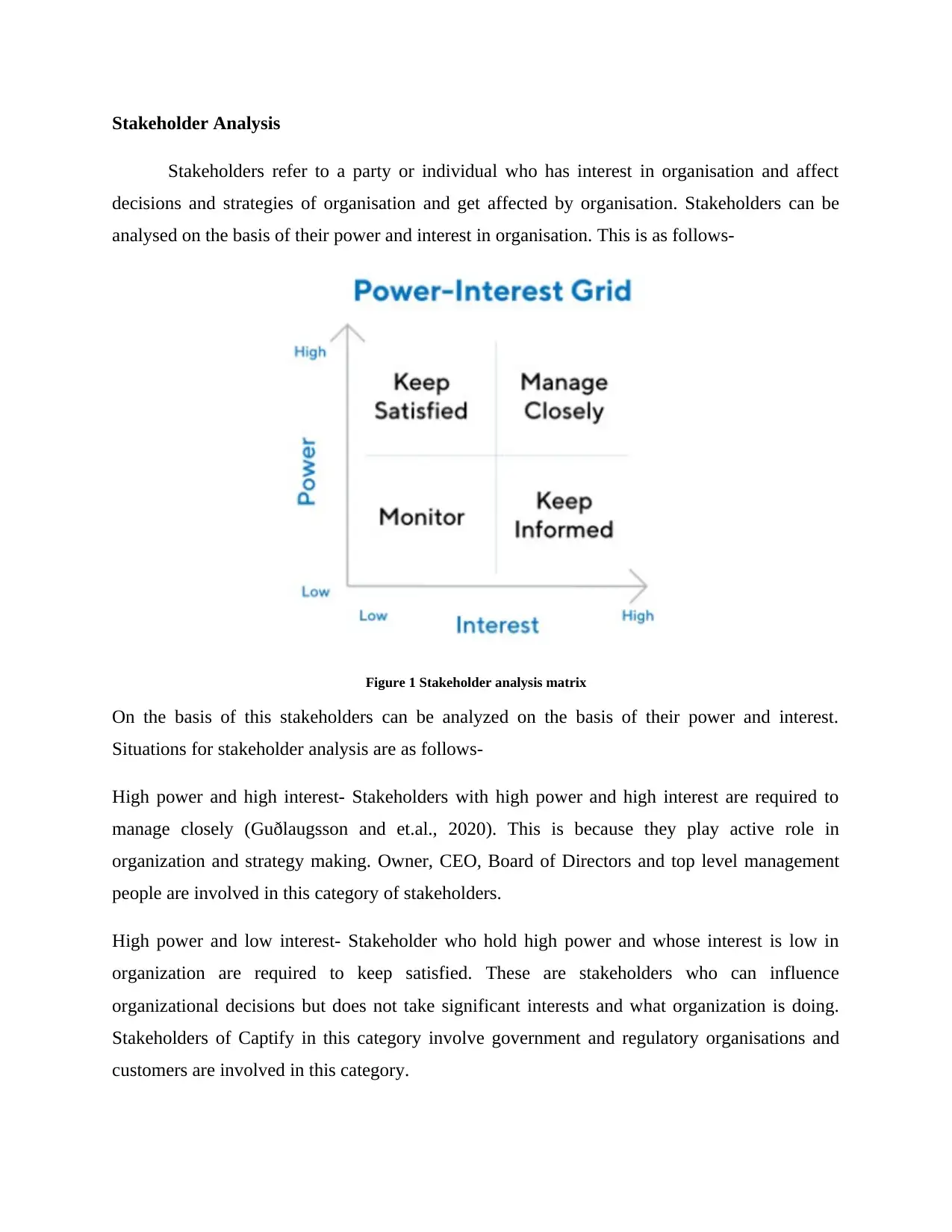
Stakeholder Analysis
Stakeholders refer to a party or individual who has interest in organisation and affect
decisions and strategies of organisation and get affected by organisation. Stakeholders can be
analysed on the basis of their power and interest in organisation. This is as follows-
Figure 1 Stakeholder analysis matrix
On the basis of this stakeholders can be analyzed on the basis of their power and interest.
Situations for stakeholder analysis are as follows-
High power and high interest- Stakeholders with high power and high interest are required to
manage closely (Guðlaugsson and et.al., 2020). This is because they play active role in
organization and strategy making. Owner, CEO, Board of Directors and top level management
people are involved in this category of stakeholders.
High power and low interest- Stakeholder who hold high power and whose interest is low in
organization are required to keep satisfied. These are stakeholders who can influence
organizational decisions but does not take significant interests and what organization is doing.
Stakeholders of Captify in this category involve government and regulatory organisations and
customers are involved in this category.
Stakeholders refer to a party or individual who has interest in organisation and affect
decisions and strategies of organisation and get affected by organisation. Stakeholders can be
analysed on the basis of their power and interest in organisation. This is as follows-
Figure 1 Stakeholder analysis matrix
On the basis of this stakeholders can be analyzed on the basis of their power and interest.
Situations for stakeholder analysis are as follows-
High power and high interest- Stakeholders with high power and high interest are required to
manage closely (Guðlaugsson and et.al., 2020). This is because they play active role in
organization and strategy making. Owner, CEO, Board of Directors and top level management
people are involved in this category of stakeholders.
High power and low interest- Stakeholder who hold high power and whose interest is low in
organization are required to keep satisfied. These are stakeholders who can influence
organizational decisions but does not take significant interests and what organization is doing.
Stakeholders of Captify in this category involve government and regulatory organisations and
customers are involved in this category.
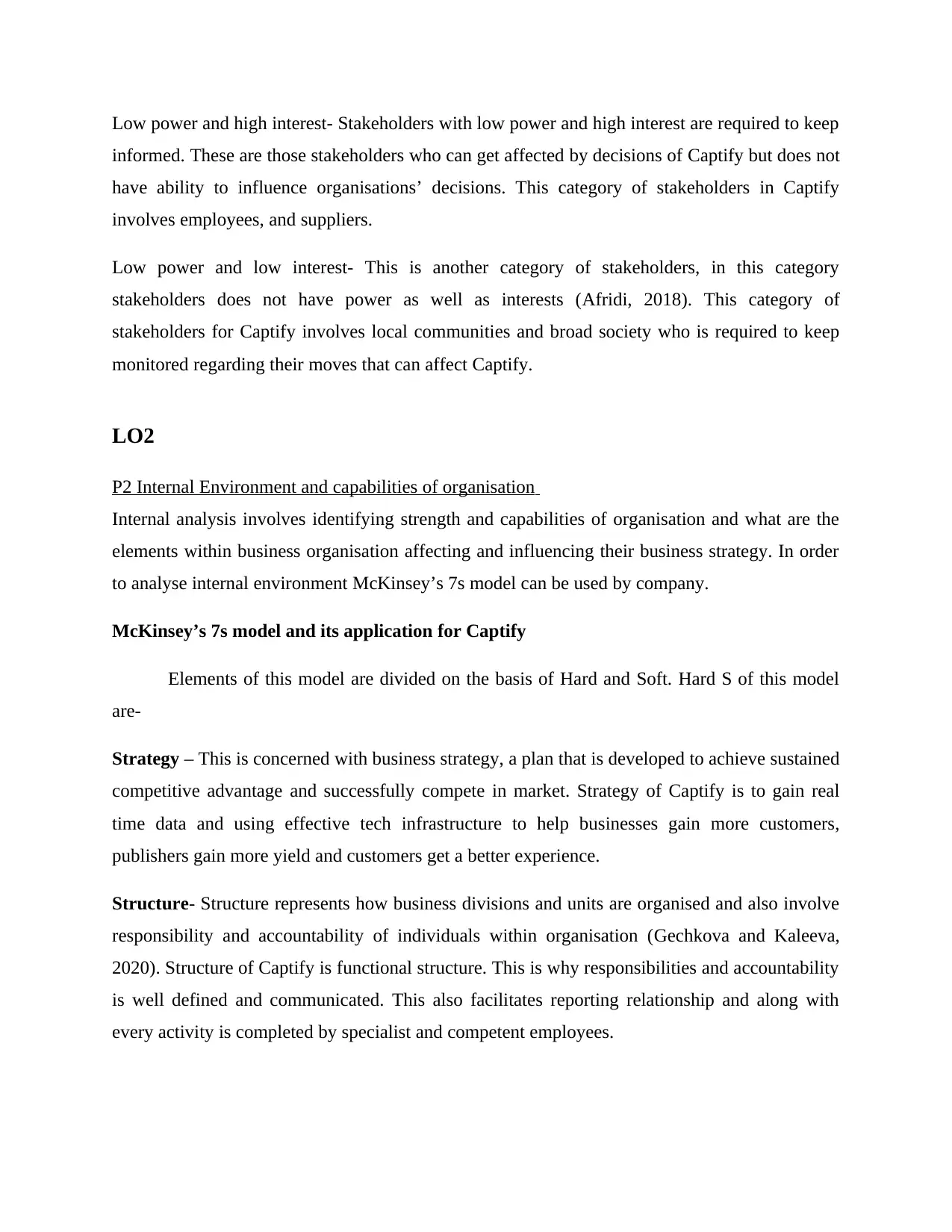
Low power and high interest- Stakeholders with low power and high interest are required to keep
informed. These are those stakeholders who can get affected by decisions of Captify but does not
have ability to influence organisations’ decisions. This category of stakeholders in Captify
involves employees, and suppliers.
Low power and low interest- This is another category of stakeholders, in this category
stakeholders does not have power as well as interests (Afridi, 2018). This category of
stakeholders for Captify involves local communities and broad society who is required to keep
monitored regarding their moves that can affect Captify.
LO2
P2 Internal Environment and capabilities of organisation
Internal analysis involves identifying strength and capabilities of organisation and what are the
elements within business organisation affecting and influencing their business strategy. In order
to analyse internal environment McKinsey’s 7s model can be used by company.
McKinsey’s 7s model and its application for Captify
Elements of this model are divided on the basis of Hard and Soft. Hard S of this model
are-
Strategy – This is concerned with business strategy, a plan that is developed to achieve sustained
competitive advantage and successfully compete in market. Strategy of Captify is to gain real
time data and using effective tech infrastructure to help businesses gain more customers,
publishers gain more yield and customers get a better experience.
Structure- Structure represents how business divisions and units are organised and also involve
responsibility and accountability of individuals within organisation (Gechkova and Kaleeva,
2020). Structure of Captify is functional structure. This is why responsibilities and accountability
is well defined and communicated. This also facilitates reporting relationship and along with
every activity is completed by specialist and competent employees.
informed. These are those stakeholders who can get affected by decisions of Captify but does not
have ability to influence organisations’ decisions. This category of stakeholders in Captify
involves employees, and suppliers.
Low power and low interest- This is another category of stakeholders, in this category
stakeholders does not have power as well as interests (Afridi, 2018). This category of
stakeholders for Captify involves local communities and broad society who is required to keep
monitored regarding their moves that can affect Captify.
LO2
P2 Internal Environment and capabilities of organisation
Internal analysis involves identifying strength and capabilities of organisation and what are the
elements within business organisation affecting and influencing their business strategy. In order
to analyse internal environment McKinsey’s 7s model can be used by company.
McKinsey’s 7s model and its application for Captify
Elements of this model are divided on the basis of Hard and Soft. Hard S of this model
are-
Strategy – This is concerned with business strategy, a plan that is developed to achieve sustained
competitive advantage and successfully compete in market. Strategy of Captify is to gain real
time data and using effective tech infrastructure to help businesses gain more customers,
publishers gain more yield and customers get a better experience.
Structure- Structure represents how business divisions and units are organised and also involve
responsibility and accountability of individuals within organisation (Gechkova and Kaleeva,
2020). Structure of Captify is functional structure. This is why responsibilities and accountability
is well defined and communicated. This also facilitates reporting relationship and along with
every activity is completed by specialist and competent employees.
⊘ This is a preview!⊘
Do you want full access?
Subscribe today to unlock all pages.

Trusted by 1+ million students worldwide
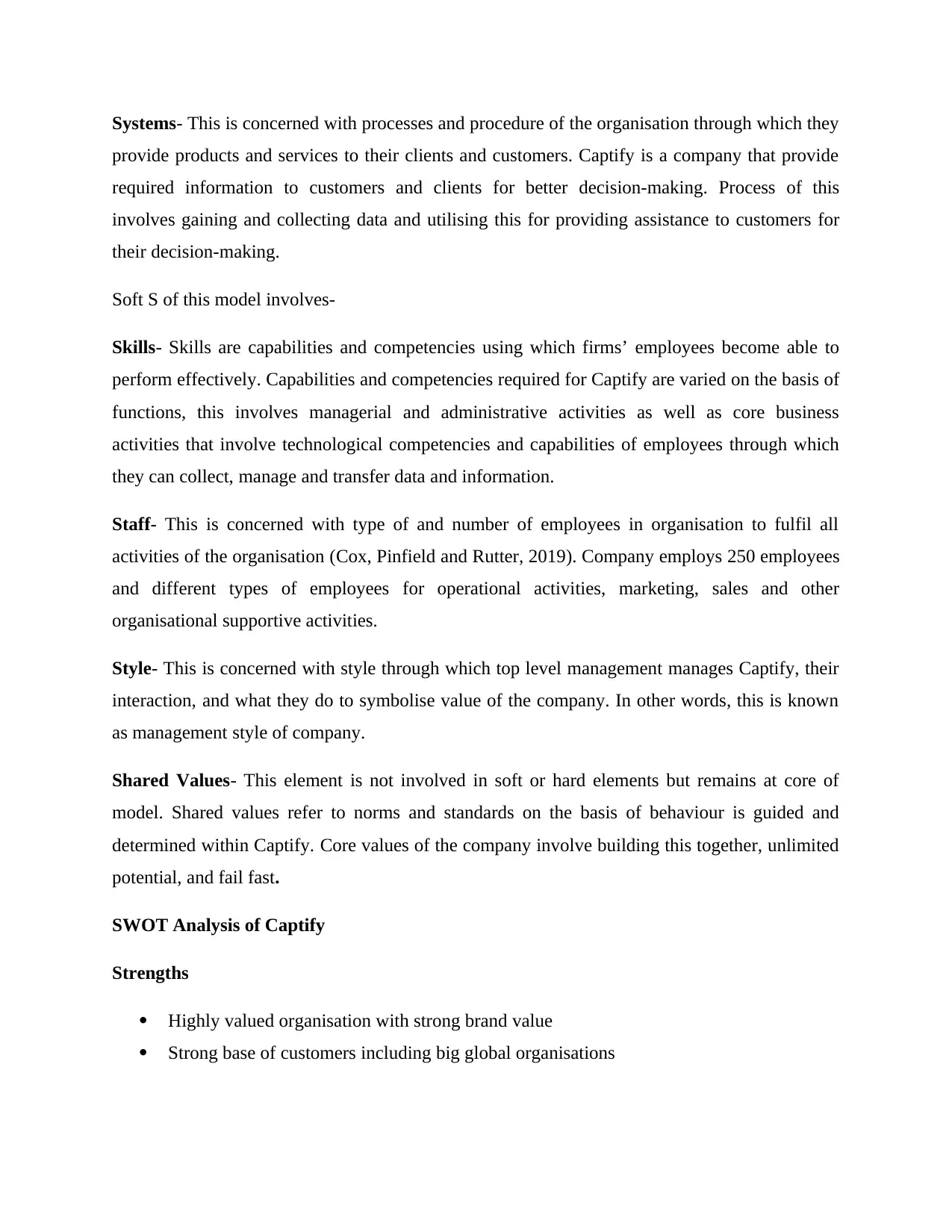
Systems- This is concerned with processes and procedure of the organisation through which they
provide products and services to their clients and customers. Captify is a company that provide
required information to customers and clients for better decision-making. Process of this
involves gaining and collecting data and utilising this for providing assistance to customers for
their decision-making.
Soft S of this model involves-
Skills- Skills are capabilities and competencies using which firms’ employees become able to
perform effectively. Capabilities and competencies required for Captify are varied on the basis of
functions, this involves managerial and administrative activities as well as core business
activities that involve technological competencies and capabilities of employees through which
they can collect, manage and transfer data and information.
Staff- This is concerned with type of and number of employees in organisation to fulfil all
activities of the organisation (Cox, Pinfield and Rutter, 2019). Company employs 250 employees
and different types of employees for operational activities, marketing, sales and other
organisational supportive activities.
Style- This is concerned with style through which top level management manages Captify, their
interaction, and what they do to symbolise value of the company. In other words, this is known
as management style of company.
Shared Values- This element is not involved in soft or hard elements but remains at core of
model. Shared values refer to norms and standards on the basis of behaviour is guided and
determined within Captify. Core values of the company involve building this together, unlimited
potential, and fail fast.
SWOT Analysis of Captify
Strengths
Highly valued organisation with strong brand value
Strong base of customers including big global organisations
provide products and services to their clients and customers. Captify is a company that provide
required information to customers and clients for better decision-making. Process of this
involves gaining and collecting data and utilising this for providing assistance to customers for
their decision-making.
Soft S of this model involves-
Skills- Skills are capabilities and competencies using which firms’ employees become able to
perform effectively. Capabilities and competencies required for Captify are varied on the basis of
functions, this involves managerial and administrative activities as well as core business
activities that involve technological competencies and capabilities of employees through which
they can collect, manage and transfer data and information.
Staff- This is concerned with type of and number of employees in organisation to fulfil all
activities of the organisation (Cox, Pinfield and Rutter, 2019). Company employs 250 employees
and different types of employees for operational activities, marketing, sales and other
organisational supportive activities.
Style- This is concerned with style through which top level management manages Captify, their
interaction, and what they do to symbolise value of the company. In other words, this is known
as management style of company.
Shared Values- This element is not involved in soft or hard elements but remains at core of
model. Shared values refer to norms and standards on the basis of behaviour is guided and
determined within Captify. Core values of the company involve building this together, unlimited
potential, and fail fast.
SWOT Analysis of Captify
Strengths
Highly valued organisation with strong brand value
Strong base of customers including big global organisations
Paraphrase This Document
Need a fresh take? Get an instant paraphrase of this document with our AI Paraphraser
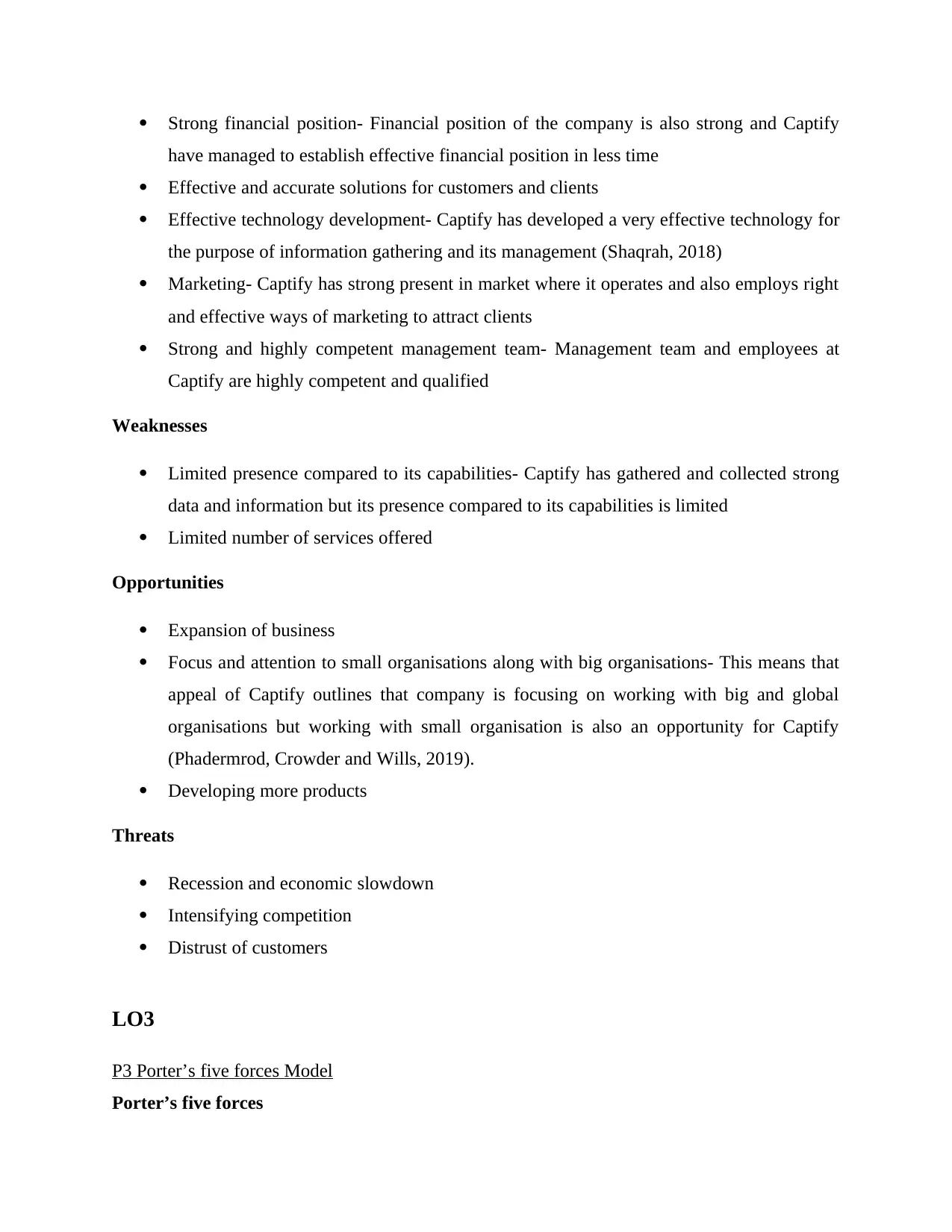
Strong financial position- Financial position of the company is also strong and Captify
have managed to establish effective financial position in less time
Effective and accurate solutions for customers and clients
Effective technology development- Captify has developed a very effective technology for
the purpose of information gathering and its management (Shaqrah, 2018)
Marketing- Captify has strong present in market where it operates and also employs right
and effective ways of marketing to attract clients
Strong and highly competent management team- Management team and employees at
Captify are highly competent and qualified
Weaknesses
Limited presence compared to its capabilities- Captify has gathered and collected strong
data and information but its presence compared to its capabilities is limited
Limited number of services offered
Opportunities
Expansion of business
Focus and attention to small organisations along with big organisations- This means that
appeal of Captify outlines that company is focusing on working with big and global
organisations but working with small organisation is also an opportunity for Captify
(Phadermrod, Crowder and Wills, 2019).
Developing more products
Threats
Recession and economic slowdown
Intensifying competition
Distrust of customers
LO3
P3 Porter’s five forces Model
Porter’s five forces
have managed to establish effective financial position in less time
Effective and accurate solutions for customers and clients
Effective technology development- Captify has developed a very effective technology for
the purpose of information gathering and its management (Shaqrah, 2018)
Marketing- Captify has strong present in market where it operates and also employs right
and effective ways of marketing to attract clients
Strong and highly competent management team- Management team and employees at
Captify are highly competent and qualified
Weaknesses
Limited presence compared to its capabilities- Captify has gathered and collected strong
data and information but its presence compared to its capabilities is limited
Limited number of services offered
Opportunities
Expansion of business
Focus and attention to small organisations along with big organisations- This means that
appeal of Captify outlines that company is focusing on working with big and global
organisations but working with small organisation is also an opportunity for Captify
(Phadermrod, Crowder and Wills, 2019).
Developing more products
Threats
Recession and economic slowdown
Intensifying competition
Distrust of customers
LO3
P3 Porter’s five forces Model
Porter’s five forces
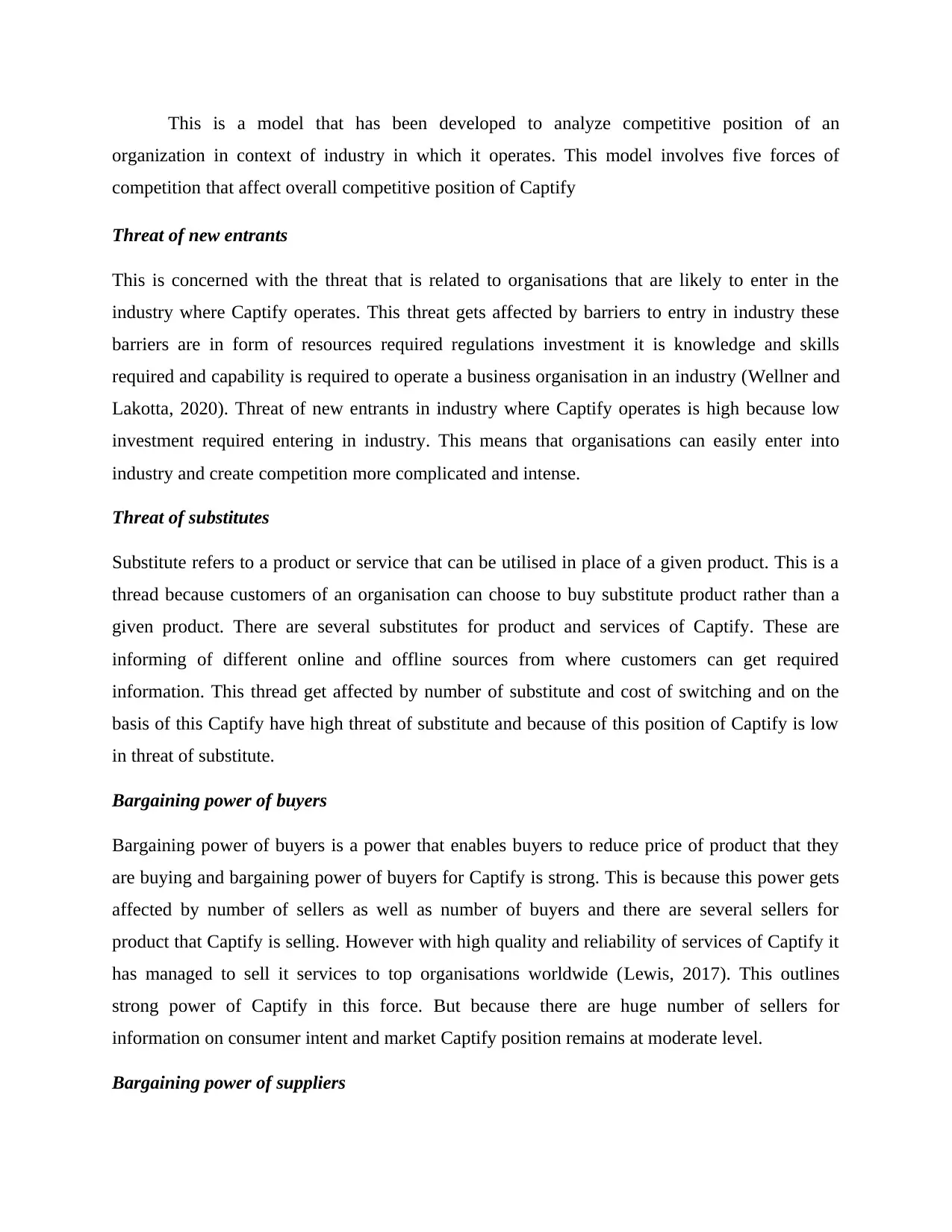
This is a model that has been developed to analyze competitive position of an
organization in context of industry in which it operates. This model involves five forces of
competition that affect overall competitive position of Captify
Threat of new entrants
This is concerned with the threat that is related to organisations that are likely to enter in the
industry where Captify operates. This threat gets affected by barriers to entry in industry these
barriers are in form of resources required regulations investment it is knowledge and skills
required and capability is required to operate a business organisation in an industry (Wellner and
Lakotta, 2020). Threat of new entrants in industry where Captify operates is high because low
investment required entering in industry. This means that organisations can easily enter into
industry and create competition more complicated and intense.
Threat of substitutes
Substitute refers to a product or service that can be utilised in place of a given product. This is a
thread because customers of an organisation can choose to buy substitute product rather than a
given product. There are several substitutes for product and services of Captify. These are
informing of different online and offline sources from where customers can get required
information. This thread get affected by number of substitute and cost of switching and on the
basis of this Captify have high threat of substitute and because of this position of Captify is low
in threat of substitute.
Bargaining power of buyers
Bargaining power of buyers is a power that enables buyers to reduce price of product that they
are buying and bargaining power of buyers for Captify is strong. This is because this power gets
affected by number of sellers as well as number of buyers and there are several sellers for
product that Captify is selling. However with high quality and reliability of services of Captify it
has managed to sell it services to top organisations worldwide (Lewis, 2017). This outlines
strong power of Captify in this force. But because there are huge number of sellers for
information on consumer intent and market Captify position remains at moderate level.
Bargaining power of suppliers
organization in context of industry in which it operates. This model involves five forces of
competition that affect overall competitive position of Captify
Threat of new entrants
This is concerned with the threat that is related to organisations that are likely to enter in the
industry where Captify operates. This threat gets affected by barriers to entry in industry these
barriers are in form of resources required regulations investment it is knowledge and skills
required and capability is required to operate a business organisation in an industry (Wellner and
Lakotta, 2020). Threat of new entrants in industry where Captify operates is high because low
investment required entering in industry. This means that organisations can easily enter into
industry and create competition more complicated and intense.
Threat of substitutes
Substitute refers to a product or service that can be utilised in place of a given product. This is a
thread because customers of an organisation can choose to buy substitute product rather than a
given product. There are several substitutes for product and services of Captify. These are
informing of different online and offline sources from where customers can get required
information. This thread get affected by number of substitute and cost of switching and on the
basis of this Captify have high threat of substitute and because of this position of Captify is low
in threat of substitute.
Bargaining power of buyers
Bargaining power of buyers is a power that enables buyers to reduce price of product that they
are buying and bargaining power of buyers for Captify is strong. This is because this power gets
affected by number of sellers as well as number of buyers and there are several sellers for
product that Captify is selling. However with high quality and reliability of services of Captify it
has managed to sell it services to top organisations worldwide (Lewis, 2017). This outlines
strong power of Captify in this force. But because there are huge number of sellers for
information on consumer intent and market Captify position remains at moderate level.
Bargaining power of suppliers
⊘ This is a preview!⊘
Do you want full access?
Subscribe today to unlock all pages.

Trusted by 1+ million students worldwide
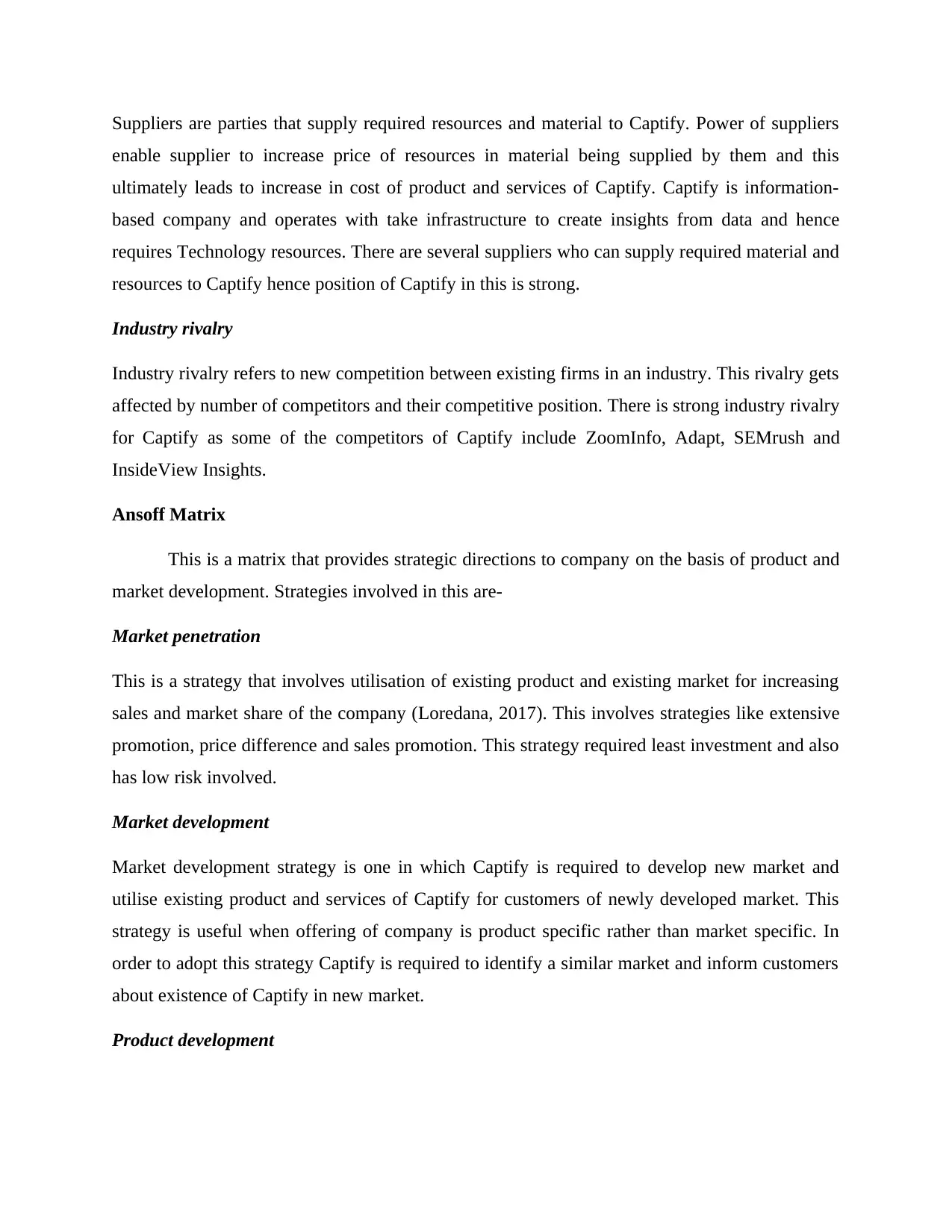
Suppliers are parties that supply required resources and material to Captify. Power of suppliers
enable supplier to increase price of resources in material being supplied by them and this
ultimately leads to increase in cost of product and services of Captify. Captify is information-
based company and operates with take infrastructure to create insights from data and hence
requires Technology resources. There are several suppliers who can supply required material and
resources to Captify hence position of Captify in this is strong.
Industry rivalry
Industry rivalry refers to new competition between existing firms in an industry. This rivalry gets
affected by number of competitors and their competitive position. There is strong industry rivalry
for Captify as some of the competitors of Captify include ZoomInfo, Adapt, SEMrush and
InsideView Insights.
Ansoff Matrix
This is a matrix that provides strategic directions to company on the basis of product and
market development. Strategies involved in this are-
Market penetration
This is a strategy that involves utilisation of existing product and existing market for increasing
sales and market share of the company (Loredana, 2017). This involves strategies like extensive
promotion, price difference and sales promotion. This strategy required least investment and also
has low risk involved.
Market development
Market development strategy is one in which Captify is required to develop new market and
utilise existing product and services of Captify for customers of newly developed market. This
strategy is useful when offering of company is product specific rather than market specific. In
order to adopt this strategy Captify is required to identify a similar market and inform customers
about existence of Captify in new market.
Product development
enable supplier to increase price of resources in material being supplied by them and this
ultimately leads to increase in cost of product and services of Captify. Captify is information-
based company and operates with take infrastructure to create insights from data and hence
requires Technology resources. There are several suppliers who can supply required material and
resources to Captify hence position of Captify in this is strong.
Industry rivalry
Industry rivalry refers to new competition between existing firms in an industry. This rivalry gets
affected by number of competitors and their competitive position. There is strong industry rivalry
for Captify as some of the competitors of Captify include ZoomInfo, Adapt, SEMrush and
InsideView Insights.
Ansoff Matrix
This is a matrix that provides strategic directions to company on the basis of product and
market development. Strategies involved in this are-
Market penetration
This is a strategy that involves utilisation of existing product and existing market for increasing
sales and market share of the company (Loredana, 2017). This involves strategies like extensive
promotion, price difference and sales promotion. This strategy required least investment and also
has low risk involved.
Market development
Market development strategy is one in which Captify is required to develop new market and
utilise existing product and services of Captify for customers of newly developed market. This
strategy is useful when offering of company is product specific rather than market specific. In
order to adopt this strategy Captify is required to identify a similar market and inform customers
about existence of Captify in new market.
Product development
Paraphrase This Document
Need a fresh take? Get an instant paraphrase of this document with our AI Paraphraser
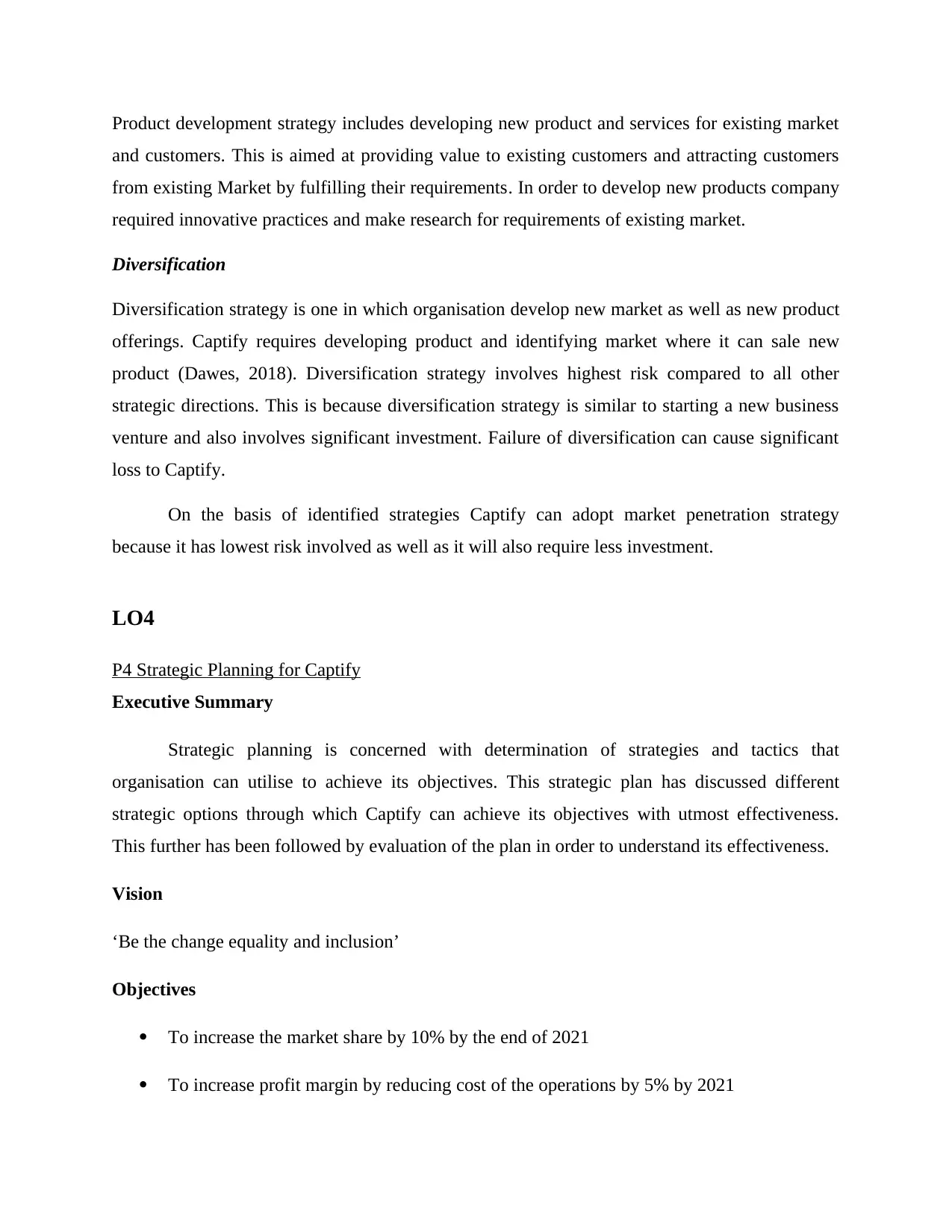
Product development strategy includes developing new product and services for existing market
and customers. This is aimed at providing value to existing customers and attracting customers
from existing Market by fulfilling their requirements. In order to develop new products company
required innovative practices and make research for requirements of existing market.
Diversification
Diversification strategy is one in which organisation develop new market as well as new product
offerings. Captify requires developing product and identifying market where it can sale new
product (Dawes, 2018). Diversification strategy involves highest risk compared to all other
strategic directions. This is because diversification strategy is similar to starting a new business
venture and also involves significant investment. Failure of diversification can cause significant
loss to Captify.
On the basis of identified strategies Captify can adopt market penetration strategy
because it has lowest risk involved as well as it will also require less investment.
LO4
P4 Strategic Planning for Captify
Executive Summary
Strategic planning is concerned with determination of strategies and tactics that
organisation can utilise to achieve its objectives. This strategic plan has discussed different
strategic options through which Captify can achieve its objectives with utmost effectiveness.
This further has been followed by evaluation of the plan in order to understand its effectiveness.
Vision
‘Be the change equality and inclusion’
Objectives
To increase the market share by 10% by the end of 2021
To increase profit margin by reducing cost of the operations by 5% by 2021
and customers. This is aimed at providing value to existing customers and attracting customers
from existing Market by fulfilling their requirements. In order to develop new products company
required innovative practices and make research for requirements of existing market.
Diversification
Diversification strategy is one in which organisation develop new market as well as new product
offerings. Captify requires developing product and identifying market where it can sale new
product (Dawes, 2018). Diversification strategy involves highest risk compared to all other
strategic directions. This is because diversification strategy is similar to starting a new business
venture and also involves significant investment. Failure of diversification can cause significant
loss to Captify.
On the basis of identified strategies Captify can adopt market penetration strategy
because it has lowest risk involved as well as it will also require less investment.
LO4
P4 Strategic Planning for Captify
Executive Summary
Strategic planning is concerned with determination of strategies and tactics that
organisation can utilise to achieve its objectives. This strategic plan has discussed different
strategic options through which Captify can achieve its objectives with utmost effectiveness.
This further has been followed by evaluation of the plan in order to understand its effectiveness.
Vision
‘Be the change equality and inclusion’
Objectives
To increase the market share by 10% by the end of 2021
To increase profit margin by reducing cost of the operations by 5% by 2021

To increase product availability by 10% by 2022
Strategic plan is based on strategies that company wants to adopt and apply for its growth and
success. Strategic direction for Captify can be identified through application of Porter’s generic
strategies.
Porter’s generic strategies
Cost leadership- Cost leadership strategy is one in which Captify needs to ensure that its cost is
lowest in the industry (Islami, Mustafa and Latkovikj, 2020). Cost leadership strategy provides
several benefits to Captify in form of high profit margin and cost leadership strategy also allows
providing benefit to customers. This attracts more customers.
Differentiation- Differentiation strategy is one in which product and service of the company is
significantly different from its competitors. This strategy provide basis for charging high price
and premium price for the services of the organisation. This strategy focuses on providing best
value to customers.
Cost focus- This strategy is similar to cost strategy but in this strategy focus of the company
narrowed down to limited customer segments. For example- Captify can apply cost focus
strategy for small size of companies and for large organisation it does not apply this strategy.
Differentiation focus- This is a strategy is one in which differentiation strategy is applied for a
particular or limited number of segments (Omsa, Abdullah and Jamali, 2017). For example- for a
certain type of companies it can provide extra value to get benefit from that market segment.
Bowman’s Strategic Clock
Strategic plan is based on strategies that company wants to adopt and apply for its growth and
success. Strategic direction for Captify can be identified through application of Porter’s generic
strategies.
Porter’s generic strategies
Cost leadership- Cost leadership strategy is one in which Captify needs to ensure that its cost is
lowest in the industry (Islami, Mustafa and Latkovikj, 2020). Cost leadership strategy provides
several benefits to Captify in form of high profit margin and cost leadership strategy also allows
providing benefit to customers. This attracts more customers.
Differentiation- Differentiation strategy is one in which product and service of the company is
significantly different from its competitors. This strategy provide basis for charging high price
and premium price for the services of the organisation. This strategy focuses on providing best
value to customers.
Cost focus- This strategy is similar to cost strategy but in this strategy focus of the company
narrowed down to limited customer segments. For example- Captify can apply cost focus
strategy for small size of companies and for large organisation it does not apply this strategy.
Differentiation focus- This is a strategy is one in which differentiation strategy is applied for a
particular or limited number of segments (Omsa, Abdullah and Jamali, 2017). For example- for a
certain type of companies it can provide extra value to get benefit from that market segment.
Bowman’s Strategic Clock
⊘ This is a preview!⊘
Do you want full access?
Subscribe today to unlock all pages.

Trusted by 1+ million students worldwide
1 out of 18
Related Documents
Your All-in-One AI-Powered Toolkit for Academic Success.
+13062052269
info@desklib.com
Available 24*7 on WhatsApp / Email
![[object Object]](/_next/static/media/star-bottom.7253800d.svg)
Unlock your academic potential
Copyright © 2020–2025 A2Z Services. All Rights Reserved. Developed and managed by ZUCOL.





